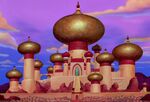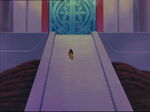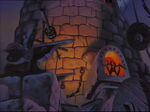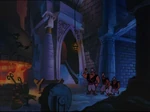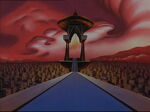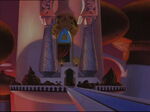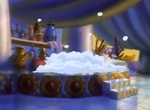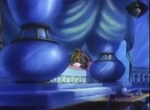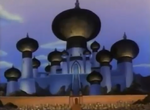"The palace looks pretty amazing, huh?"
—Aladdin to Jasmine
The Sultan's Palace is a colossal structure that serves as the home of Agrabah's Sultan, Princess Jasmine, and most recently Aladdin. The palace appears in all Aladdin-related media. The design is loosely based on the Taj Mahal, which is located in India.
Background[]
The palace is located at the end of Agrabah, and can be seen from anywhere in the town. The palace itself is surrounded by high walls, with a main gate granting entrance. A small area on the wall is outfitted for the Sultan to make speeches and announcements to the people.
The palace itself is mostly white in color, with golden domed roofs. There are multiple towers of varying sizes. Inside, there are various rooms that are used by the Sultan and his family. Outside, in the area between the walls and the building itself, is a large garden, as well as a fountain. At night, the palace is illuminated.
The palace serves as a major setting in all Aladdin films, as well as the TV series. In Aladdin, Jasmine considers the palace to be something of a prison, as she at first tires of her life as a princess. Meanwhile, Aladdin dreams of living there. Later in the film, Jafar has the Genie move the palace to a nearby mountain overlooking the city (as he wanted to "rule on high"), though it is restored to its original location at the end of the film. In The Return of Jafar and the Aladdin series, it shows that Aladdin does not live in the palace, but he regularly visits it. In Aladdin and the King of Thieves, a pavilion behind the palace serves as the site of Aladdin and Jasmine's wedding.
Places of Interest[]
- Throne Room: Where the Sultan governs Agrabah from day to day. In the center point is a large throne shaped like an elephant.
- Jasmine's Room: The personal quarters of Princess Jasmine. The room opens up to a large balcony overlooking the city.
- Jafar's Room: Jafar's personal chambers, where he got some rest and use from his opium hookah. This room is very spacious, has red walls, and it's very dark.
- Jafar's Lair: A hidden area of the palace, where Jafar and Iago did most of their plotting. It includes the various instruments he used in his alchemy.
- Dungeon: Where prisoners are held. A disguised Jafar meets Aladdin here to convince the boy to enter the Cave of Wonders. It contains a secret passageway to freedom.
- Garden: Where Jasmine usually spends time with Rajah. It is surrounded by large walls and also works as a back entry way into the palace. There are doves and a large fountain.
- Toy Room/Storage Room: Where the Sultan keeps various toys, trinkets and collectibles, including a model of Agrabah.
Trivia[]
- The palace's gold and cream color scheme matches that of the Sultan.
- The throne room was designed to echo the Sultan's rounded shape. This is reflected in the elephant throne, egg-shaped columns, and rounded oil lamps. During Jafar's reign, the shapes within the room appear as sharp and angular to reflect Jafar's silhouette. For example, the Sultan's elephant throne was converted to a cobra.
- In homage to the Beast's cameo in Aladdin, the Sultan's Palace appears twice during the musical number "Be Our Guest" in place of the Eiffel Tower in 2017's live-action Beauty and the Beast.
- The palace can be seen in the background during Vanellope von Schweetz's visit to Oh My Disney in Ralph Breaks the Internet.
- In the 2019 movie, the palace has a direct access to the sea allowing for private commercial tradings.

